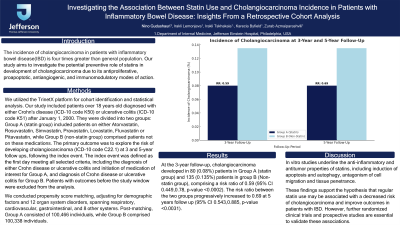Monday Poster Session
Category: IBD
P2569 - Investigating the Association Between Statin Use and Cholangiocarcinoma Incidence in Patients With Inflammatory Bowel Disease: Insights From a Retrospective Cohort Analysis
Monday, October 28, 2024
10:30 AM - 4:00 PM ET
Location: Exhibit Hall E

Has Audio

Nino Gudushauri, MD
Jefferson Einstein Hospital
Philadelphia, PA
Presenting Author(s)
Nino Gudushauri, MD1, Irakli Lemonjava, MD1, Karecia Byfield, MBBS2, Irakli Tskhakaia, MD1, Zurab Azmaiparashvili, MD, MSc1
1Jefferson Einstein Hospital, Philadelphia, PA; 2Albert Einstein Medical Center, Philadelphia, PA
Introduction: The incidence of cholangiocarcinoma in patients with inflammatory bowel disease (IBD) is four times greater than general population. Our study aims to investigate the potential preventive role of statins in development of cholangiocarcinoma due to its antiproliferative, proapoptotic, antiangiogenic, and immunomodulatory modes of action.
Methods: We utilized the TrinetX platform for cohort identification and statistical analysis. Our study included patients over 18 years old diagnosed with either Crohn's disease (ICD-10 code K50) or ulcerative colitis (ICD-10 code K51) after January 1, 2000. They were divided into two groups: Group A (statin group) included patients on either Atorvastatin, Rosuvastatin, Simvastatin, Pravastatin, Lovastatin, Fluvastatin or Pitavastatin, while Group B (non-statin group) comprised patients not on these medications. The primary outcome was to explore the risk of developing cholangiocarcinoma (ICD-10 code C22.1) at 3 and 5-year follow ups, following the index event. The index event was defined as the first day meeting all selected criteria, including the diagnosis of either Crohn disease or ulcerative colitis and initiation of medication of interest for Group A, and diagnosis of Crohn disease or ulcerative colitis for Group B. Patients with outcomes before the study window were excluded from the analysis.
We conducted propensity score matching, adjusting for demographic factors and 12 organ system disorders, spanning respiratory, cardiovascular, gastrointestinal, and 9 other systems. Post-matching, Group A consisted of 100,466 individuals, while Group B comprised 100,338 individuals.
Results: At the 3-year follow-up, cholangiocarcinoma developed in 80 (0.08%) patients in Group A (statin group) and 135 (0.135%) patients in group B (Non-statin group), comprising a risk ratio of 0.59 (95% CI 0.449,0.78, p-value < 0.0002). The risk ratio between the two groups progressively increased to 0.69 at 5 years follow up (95% CI 0.543,0.885, p-value < 0.0031).
Discussion: In vitro studies underline the anti-inflammatory and antitumor properties of statins, including induction of apoptosis and autophagy, antagonism of cell migration and tissue penetrance.
These findings support the hypothesis that regular statin use may be associated with a decreased risk of cholangiocarcinoma and improve outcomes in patients with IBD. However, further randomized clinical trials and prospective studies are essential to validate these associations.
Disclosures:
Nino Gudushauri, MD1, Irakli Lemonjava, MD1, Karecia Byfield, MBBS2, Irakli Tskhakaia, MD1, Zurab Azmaiparashvili, MD, MSc1. P2569 - Investigating the Association Between Statin Use and Cholangiocarcinoma Incidence in Patients With Inflammatory Bowel Disease: Insights From a Retrospective Cohort Analysis, ACG 2024 Annual Scientific Meeting Abstracts. Philadelphia, PA: American College of Gastroenterology.
1Jefferson Einstein Hospital, Philadelphia, PA; 2Albert Einstein Medical Center, Philadelphia, PA
Introduction: The incidence of cholangiocarcinoma in patients with inflammatory bowel disease (IBD) is four times greater than general population. Our study aims to investigate the potential preventive role of statins in development of cholangiocarcinoma due to its antiproliferative, proapoptotic, antiangiogenic, and immunomodulatory modes of action.
Methods: We utilized the TrinetX platform for cohort identification and statistical analysis. Our study included patients over 18 years old diagnosed with either Crohn's disease (ICD-10 code K50) or ulcerative colitis (ICD-10 code K51) after January 1, 2000. They were divided into two groups: Group A (statin group) included patients on either Atorvastatin, Rosuvastatin, Simvastatin, Pravastatin, Lovastatin, Fluvastatin or Pitavastatin, while Group B (non-statin group) comprised patients not on these medications. The primary outcome was to explore the risk of developing cholangiocarcinoma (ICD-10 code C22.1) at 3 and 5-year follow ups, following the index event. The index event was defined as the first day meeting all selected criteria, including the diagnosis of either Crohn disease or ulcerative colitis and initiation of medication of interest for Group A, and diagnosis of Crohn disease or ulcerative colitis for Group B. Patients with outcomes before the study window were excluded from the analysis.
We conducted propensity score matching, adjusting for demographic factors and 12 organ system disorders, spanning respiratory, cardiovascular, gastrointestinal, and 9 other systems. Post-matching, Group A consisted of 100,466 individuals, while Group B comprised 100,338 individuals.
Results: At the 3-year follow-up, cholangiocarcinoma developed in 80 (0.08%) patients in Group A (statin group) and 135 (0.135%) patients in group B (Non-statin group), comprising a risk ratio of 0.59 (95% CI 0.449,0.78, p-value < 0.0002). The risk ratio between the two groups progressively increased to 0.69 at 5 years follow up (95% CI 0.543,0.885, p-value < 0.0031).
Discussion: In vitro studies underline the anti-inflammatory and antitumor properties of statins, including induction of apoptosis and autophagy, antagonism of cell migration and tissue penetrance.
These findings support the hypothesis that regular statin use may be associated with a decreased risk of cholangiocarcinoma and improve outcomes in patients with IBD. However, further randomized clinical trials and prospective studies are essential to validate these associations.
Disclosures:
Nino Gudushauri indicated no relevant financial relationships.
Irakli Lemonjava indicated no relevant financial relationships.
Karecia Byfield indicated no relevant financial relationships.
Irakli Tskhakaia indicated no relevant financial relationships.
Zurab Azmaiparashvili indicated no relevant financial relationships.
Nino Gudushauri, MD1, Irakli Lemonjava, MD1, Karecia Byfield, MBBS2, Irakli Tskhakaia, MD1, Zurab Azmaiparashvili, MD, MSc1. P2569 - Investigating the Association Between Statin Use and Cholangiocarcinoma Incidence in Patients With Inflammatory Bowel Disease: Insights From a Retrospective Cohort Analysis, ACG 2024 Annual Scientific Meeting Abstracts. Philadelphia, PA: American College of Gastroenterology.
